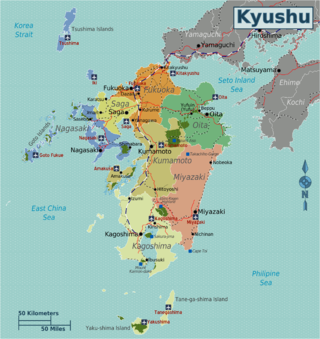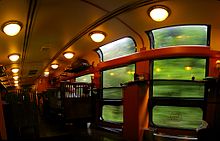Kyūshū (九州) is the southernmost of the four main islands of Japan. The climate is slightly warmer and more tropical than Honshu, and the southern and eastern coasts are regularly battered by typhoons each year. The terrain is generally mountainous with very fertile valleys much like the rest of Japan, except for the wide plain area at the top of the island - the location of the largest cities of Fukuoka and Kitakyushu.
Prefectures

| Fukuoka home of the cities of Fukuoka and Kitakyushu |
| Saga small and rustic, famous for pottery and pre-historic village ruins |
| Nagasaki best known for the eponymous city of Nagasaki, a hilly city known as the only "foreigners port" during Japan's isolationist period and target of the 2nd atomic bombing attack during World War II |
| Oita rural area well known for abundant onsen hot springs, especially Beppu |
| Kumamoto center of the isle of Kyushu, location of the Aso caldera, largest in the world, and the beautiful Amakusa chain of islands |
| Miyazaki the surfers' destination of Japan with big beaches and big waves, plus the stunning Takachiho Gorge with its Shinto shrines |
| Kagoshima dominated by the Sakurajima volcano, hot enough to grow sugarcane - get buried on hot-sand beaches, or visit the two famous islands of Yakushima and Tanegashima |

The islands of Okinawa, leading southwest of Japan to Taiwan, are sometimes considered a part of Kyushu, and in fact the northernmost islands in the chain are administered by Kagoshima prefecture.
Cities

- 1 Beppu - One of the most famous hot spring towns in Japan, there are more here than anywhere else in the nation
- 2 Fukuoka - the largest city and main transport hub. Lots of shopping, museums, unique architecture, one of the three big sumo tournament...
- 3 Kagoshima - southern city in the shadow of the Sakurajima volcano
- 4 Karatsu - A coastal castle town known for its Squid market
- 5 Kitakyushu - Kyushu's main port town. A castle, a preserved historical port, a space theme park...
- 6 Kumamoto - castle town and hub to central Kyushu
- 7 Miyazaki - beach resort area in southern Kyushu. Surfing, golf, and Aoshima
- 8 Nagasaki - Japan's first port open to the West, home to the oldest continuous Chinatown, and the site of an atomic bombing at the end of WWII.
- 9 Sasebo - Home to a U.S. Navy base
Other destinations
- 1 Amakusa - Three islands where many "Hidden Christians" practiced when Christianity was illegal, also known for dolphin watching.
- 2 Amami Islands - subtropical archipelago halfway to Okinawa
- 3 Mount Aso - an active volcano
- 4 Kirishima - a mountainous national park chock full of volcanic craters and hot springs
- 5 Kushima - A rural town known for its wild horses, the Misaki horse, and great surfing
- 6 Takachiho - A scenic gorge with deep ties to Shintoism
- 7 Tanegashima - island home of Japan's space program
- 8 Tsushima - An island that was formerly its own province known for its unique endangered cat species.
- 9 Yakushima - subtropical island famous for its giant cedars
Talk
Kyushu is home to dialects of Japanese that are almost incomprehensible to speakers of standard Japanese -so much so that it was utilised during World War 2 for preventing interception by the Allies of Japanese communications. Even native speakers of Japanese from Honshu often have problems understanding the conversations of locals. However, most people are able to speak standard Japanese and especially in the cities younger people may also have a decent command of English.
Get in
By plane
Fukuoka (FUK IATA) is Japan's busiest international hub after the trio of Tokyo, Chubu and Kansai and has excellent connections throughout Asia and Japan. All the other prefectural capitals also offer limited service within Japan and to a few major Asian cities (typically Seoul and Shanghai).
By train
The San'yo Shinkansen line runs from Osaka to Fukuoka and many trains continue along the Kyushu Shinkansen line to Kagoshima. All Shinkensen trains stop at Kokura Station in Kitakyushu and Hakata Station in Fukuoka; a trip by train all the way from Tokyo takes about 5 hours by Nozomi and costs ¥23,150. There are no Hikari trains that go the full distance from Tokyo to Hakata, so With the JR Pass, you'll need to change trains. You can also go from Osaka to Hakata with the JR West San'yo Pass.
The Kyushu Shinkansen crosses the west side of the island to Kagoshima in the south. Many trains to Kagoshima start in Osaka, and the full course takes about 3.75 hours by Mizuho and ¥22,210. The JR pass is not accepted on Mizuho trains, but they are accepted on Sakura trains which make the journey in 4 hours. A journey from Tokyo (with a change in Osaka) takes a little over 6.5 hours and costs about ¥30,500, add an hour with the JR Pass for a Hikari to Sakura connection in Shin-Osaka or Okayama.
The Hakata to Kagoshima run takes about 1.5 hours. There are also good Limited Express trains servicing most anywhere of interest on the island, so you can take train from Hakata to just about anywhere else of interest on the island in about an hour in a half. The exception being Miyazaki which is about four hours from Hakata.
By bus
Willer Express is a company which provides daily night time bus services from Nagoya, Tokyo, and Osaka to Kyushu. They offer an online booking services in Japanese, English and Korean.
By boat
Fukuoka is also the gateway to South Korea via Busan by ferry, and a few ferry companies (including JR) operate the route.
Get around
By train


The train is the transport mode of choice on Kyushu. The Kyushu Shinkansen zips across from Fukuoka (Hakata) via Kumamoto to Kagoshima in 1:20, and there is fairly rapid limit express network to get anywhere else. There are also some scenic local train lines such as the JR Hisatsu Line (肥薩線) from Kumamoto via Yatsushiro to Hayato (near Kagoshima) is considered one of the most scenic in Japan, and there are comfortable, sightseeing oriented, trains on these lines, and there are some runs with unique roll stock, most notably the Aso Boy from Kumamoto to Mt. Aso and the Steam Locomotive Hitoyoshi from Kumamoto to Hitoyoshi, along the Hisatsu Line.
The Kyushu Rail Pass, available only to visitors on tourist visas, offers unlimited travel on JR Kyushu's lines, including the Kyushu Shinkansen but not the San'yo Shinkansen to Hakata. Keep in mind, that the limited express trains throughout Kyushu are fairly reasonably priced, so the 3 day pass is probably not going to save money unless you're using taking the Shinkansen or spending a lot of time on the train.
The prices of the pass are as follows:Northern Kyushu Area3-day pass ¥7,200 5-day pass ¥9,260
All Kyushu Area3-day pass ¥14,400 5-day pass ¥17,490
By bus
Buses serve those parts of Kyushu outside the railway network, but schedules tend to be very limited. There is also a highway bus system paralleling the train network, for which reservations can be done on a portal website. They also offer SUNQ 3-4 day unlimited travel passes: 4-day All Kyushu Pass ¥14,000; 3-day All Kyushu Pass ¥10,000; 3-day Northern Kyushu Pass ¥8,000.
See
Castles
Kyushu doesn't have any original castles, but there are still some noteworthy reconstructions and interesting ruins to explore. Kumamoto Castle (Kumamoto) was often considered to be the best reconstructed castle in the nation, because they not only rebuilt the castle keep, they also rebuilt most of the other structures in the castle grounds. Unfortunately, the castle keep and many other structures were severely damaged in the 2016 Kumamoto Earthquake. It has been closed since that time and works to rebuild and restore the castle are ongoing. It is projected that the keep will be completed as early as 2019 while the full restoration of all buildings and walls is not expected to be completed until the 2030s.
Saga Castle in Saga features one of the best palace reconstructions in the nation. They had to obtain special permission in order to build the palace at full scale in its authentic form due to size restrictions on wooden buildings.
Do
Eat
Drink
Kyushu is the home of shōchū (焼酎), the fiery Japanese distilled liquor. It's typically around 25%, but some varieties can be much stronger. It can be distilled from nearly anything including rice, barley, brown sugar and buckwheat, but Kyushu is best known for potato shōchū (芋焼酎 imojōchū), particularly that from the ancient province of Satsuma (modern-day Kagoshima).
Stay safe
Carry a cellphone with you at all times and avoid areas where there are no streetlights, people, or busy shops/restaurants (just like anywhere else!).
Go next
The Chugoku region offers many great experiences for travellers, such as:
- Hiroshima, the first city to experience an atomic bombing
- Okayama, home to one of Japan's Three Famous Gardens
- Izumo, with the second holiest Shinto Shrine in Japan
- Tottori, with Japan's only sand dunes.
